Ice-Water-Gas Interaction during Icebreaking by an Airgun Bubble
Abstract
:1. Introduction
2. Experimental Set-Up and Principles
2.1. The Laboratory-Scale Airgun
2.2. Experimental Set-Up
2.3. Bubble Shape and Nondimensionalization
3. Results and Discussions
3.1. Pressure Measurement
3.2. Typical Case Study
3.3. The Damage Patterns of Ice under Airgun Bubble Loads
- (1)
- Radial slits pattern
- (2)
- Radial and circumferential slits pattern
- (3)
- Radial cracks pattern
- (4)
- No crack pattern
3.4. Influence of Parameters
3.5. Repeatability and Randomness of the Results
4. Conclusions
- 1.
- Influenced by the airgun structure, the shape of the bubble was not spherical in the expansion stage but presented a unique ‘pear-like’ shape, which was quite different from the spherical shape of the spark bubble. An initial shock wave was accompanied by the generation of the airgun bubble, followed by oscillatory pressure peaks caused by the directional fast air injection, then cycles of shock waves with damping amplitudes along with the minimum volumes of the bubble. At the same time, a bubble jet and its induced high-pressure peak (even higher than that induced by shock wave) were also observed and measured. The initial shockwave and secondary shockwave together with the jet impact were expected to contribute to the icebreaking mainly.
- 2.
- High-pressure airgun bubbles had more cycles underwater than spark bubbles did. As a result, the retarded flow formed by bubble pulsation and collapse played an important role in the process of icebreaking. It aggravated the cracks extending into slits and pushed the ice plate breaking up along the slits. Moreover, once the ice plate separated, a free surface appeared and a spike may have also been generated, which enhanced the effect of icebreaking significantly.
- 3.
- There were three typical patterns of icebreaking under the airgun bubble: ‘radial slits’ pattern, ‘radial and circumferential slits’ pattern, and ‘radial cracks’ pattern, under different parameters. For the former two, both initial shock waves and secondary shock wave together with bubble jet can induce these patterns. According to different reasons, the first pattern was further classified as ‘radial slits (shock wave)’ and ‘radial slits (jet)’, whereas the second pattern was further classified as ‘radial and circumferential (shock wave) slits’ and ‘radial (shock wave) and circumferential (jet) slits’. The third one was most scarce, as it had very strict conditions for both ice thickness parameters and distance parameters simultaneously.
- 4.
- The selection of an optimal distance of the bubble is an important problem for practical icebreaking application. It involves many factors, such as ice properties, bubble properties, boundary conditions, etc. As far as the parameters (H and T) concerned in this paper, the smaller the H was, the better the icebreaking effect was. This may be because shockwaves could contribute more at a nearer distance to the ice. Further study on this problem will be continued involving more parameters.
Author Contributions
Funding
Institutional Review Board Statement
Informed Consent Statement
Data Availability Statement
Conflicts of Interest
Appendix A. The Detailed Development of the Bubble Jet and Volume
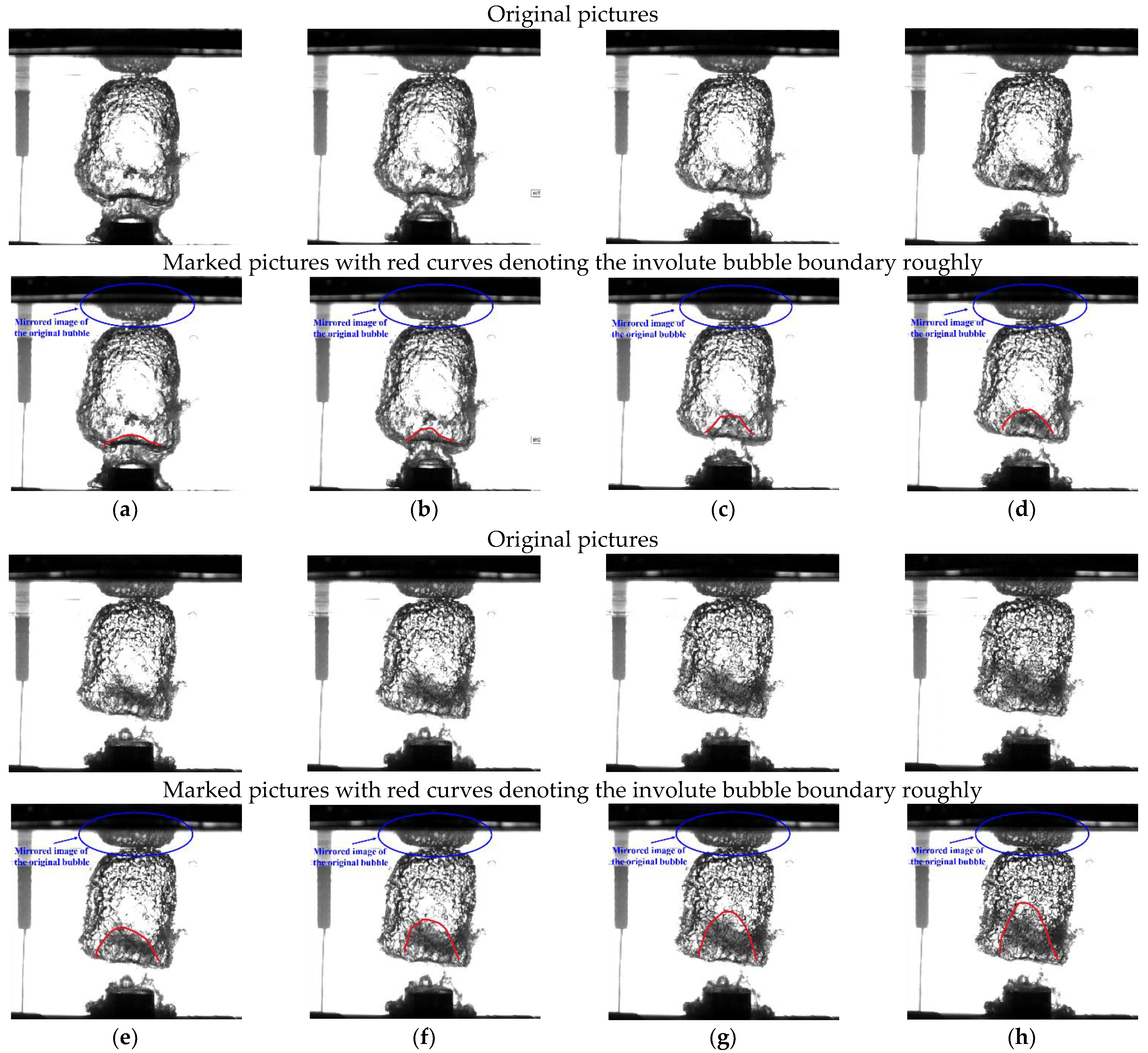
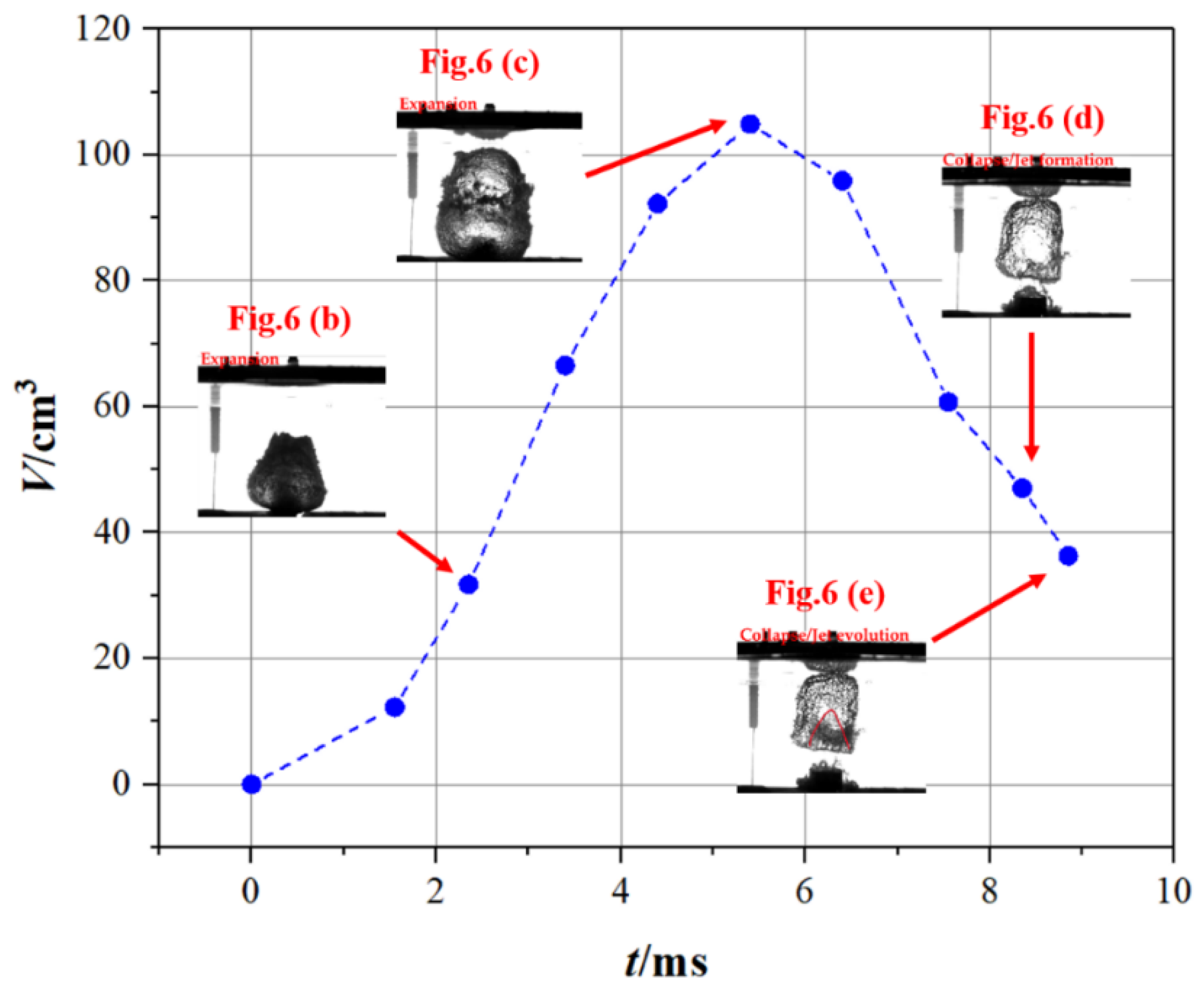
References
- Sazonov, K.; Dobrodeev, A. Ice Resistance Assessment for a Large Size Vessel Running in a Narrow Ice Channel Behind an Icebreaker. J. Mar. Sci. Appl. 2021, 20, 446–455. [Google Scholar] [CrossRef]
- Ni, B.Y.; Chen, Z.W.; Zhong, K.; Ll, X.A.; Xue, Y.Z. Numerical simulation of a polar ship moving in level ice based on a one-way coupling method. J. Mar. Sci. Eng. 2020, 8, 692. [Google Scholar] [CrossRef]
- Du, Y.; Sun, L.; Pang, F.; Li, H.; Gao, C. Experimental Research of Hull Vibration of a Full-Scale River Icebreaker. J. Mar. Sci. Appl. 2020, 19, 182–194. [Google Scholar] [CrossRef]
- Zhai, M.X.; Li, X.Q.; Hui, F.M.; Cheng, X.; Heil, P.; Zhao, T.C.; Jiang, T.Y.; Cheng, C.; Ci, T.Y.; Liu, Y.; et al. Sea-ice conditions in the Adélie Depression, Antarctica, during besetment of the icebreaker RV Xuelong. Ann. Glaciol. 2015, 56, 160–166. [Google Scholar] [CrossRef]
- Wang, Z.; Turner, J.; Sun, B.; Li, B.; Liu, C. Cyclone-induced rapid creation of extreme Antarctic sea ice conditions. Sci. Rep. 2014, 4, 5317. [Google Scholar] [CrossRef]
- Ni, B.Y.; Wang, Q.; Xue, Y.Z.; Wang, Y.; Wu, Q.G. Numerical Simulation on the Damage of Ice Floe by High-Pressure Bubble Jet Loads, 3rd ed.; Workshop and Symposium on Safety and Integrity Management of Operations in Harsh Environments: St. John’s, NL, Canada, 2017. [Google Scholar]
- Ni, B.Y.; Pan, Y.T.; Yuan, G.Y.; Xue, Y.Z. An experimental study on the interaction between a bubble and an ice floe with a hole. Cold Reg. Sci. Technol. 2021, 187, 103281. [Google Scholar] [CrossRef]
- Cui, P.; Zhang, A.M.; Wang, S.; Khoo, B.C. Ice breaking by a collapsing bubble. J. Fluid Mech. 2018, 841, 287–309. [Google Scholar] [CrossRef]
- Kan, X.Y.; Zhang, A.M.; Yan, J.L.; Wu, W.B.; Liu, Y.L. Numerical investigation of ice breaking by a high-pressure bubble based on a coupled BEM-PD model. J. Fluids Struct. 2020, 96, 103016. [Google Scholar] [CrossRef]
- Yuan, G.Y.; Ni, B.Y.; Wu, Q.G.; Xue, Y.Z.; Zhang, A.M. An experimental study on the dynamics and damage capabilities of a bubble collapsing in the neighborhood of a floating ice cake. J. Fluids Struct. 2020, 92, 102833. [Google Scholar] [CrossRef]
- Jorgensen, J.K.; Gyselman, E.C. Hydroacoustic measurements of the behavioural response of arctic riverine fishes to seismic airguns. J. Acoust. Soc. Am. 2009, 126, 1598–1606. [Google Scholar] [CrossRef]
- Hermannsen, L.; Tougaard, J.; Beedholm, K.; Nabe-Nielsen, J.; Madsen, P.T. Characteristics and propagation of airgun pulses in shallow water with implications for effects on small marine mammals. PLoS ONE 2015, 10, e0133436. [Google Scholar] [CrossRef] [PubMed]
- Chahine, G.L.; Kalumuck, K.M.; Hsiao, C.T. Simulation of surface piercing body coupled response to underwater bubble dynamics utilizing 3DYNAFS, a three-dimensional BEM code. Comput. Mech. 2003, 32, 319–326. [Google Scholar] [CrossRef]
- Goh, B.H.T.; Gong, S.W.; Ohl, S.W.; Khoo, B.C. Spark-generated bubble near an elastic sphere. Int. J. Multiph. Flow 2017, 90, 156–166. [Google Scholar] [CrossRef]
- Chen, H.L.; Ni, B.Y.; Hu, W.J.; Xue, Y.Z. Model experimental study of damage effects of Ship structures under the contact jet loads of bubble in a water tank. Shock Vib. 2018, 2018, 8456925. [Google Scholar] [CrossRef]
- Tatlisuluoglu, A.; Beji, S. Blast Pressure Measurements of an Underwater Detonation in the Sea. J. Mar. Sci. Appl. 2021, 20, 706–713. [Google Scholar] [CrossRef]
- Duan, Y.S.; Wang, X.H.; Liu, S.B. Application of blasting technique to against ice jam. J. Glaciol. Geocryol. 2003, 25, 220–226. [Google Scholar]
- Barash, R.M. Ice-Breaking by Explosives; Naval Ordnance Laboratory Technical Report NOLTR 66–29; Naval Ordnance Laboratory: White Oak, MD, USA, 1966. [Google Scholar]
- Mellor, M. Breaking Ice with Explosives; USA Cold Regions Research and Engineering Laboratory: Hanover, NH, USA, CRREL Report 82-40; 1982. [Google Scholar]
- Mellor, M. Derivation of guidelines for blasting floating ice. Cold Reg. Sci. Technol. 1987, 13, 193–206. [Google Scholar] [CrossRef]
- Wang, Y.; Qin, Y.; Yao, X. A combined experimental and numerical investigation on damage characteristics of ice sheet subjected to underwater explosion load. Appl. Ocean. Res. 2020, 103, 102347. [Google Scholar] [CrossRef]
- Wang, Y.; Qin, Y.Z.; Wang, Z.K.; Yao, X.L. Numerical study on ice damage characteristics under single explosive and combination explosives. Ocean. Eng. 2021, 223, 108688. [Google Scholar] [CrossRef]
- Asuelimen, G.; Blanco-Davis, E.; Wang, J.; Yang, Z.L.; Matellini, D.B. Formal Safety Assessment of a Marine Seismic Survey Vessel Operation, Incorporating Risk Matrix and Fault Tree Analysis. J. Mar. Sci. Appl. 2020, 19, 155–172. [Google Scholar] [CrossRef]
- Giles, B.F. Pneumatic acoustic energy source. Geophys. Prospect. 1968, 16, 21–53. [Google Scholar] [CrossRef]
- Chen, Y.; Zhang, X.K.; Qiu, X.L.; Ge, H.K.; Liu, B.J.; Wang, B.S. A new method to generate seismic wave on the land. Chin. Sci. Bull. 2007, 11, 1317–1321. (In Chinese) [Google Scholar]
- Chelminski, S.; Watson, L.M.; Ronen, S. Research Note: Low-frequency pneumatic seismic sources. Geophys. Prospect. 2019, 67, 1547–1556. [Google Scholar] [CrossRef]
- Mellor, M.; Kovacs, A. Breakage of Floating Ice by Compressed Gas Blasting; Cold Regions Research and Engineering Laboratory (CRREL): Hanover, New Hampshire, USA, 1972; pp. 1–9, Special Report 184. [Google Scholar]
- Coburn, J.L., Jr.; Ehrlich, N.A. Advanced icebreaking concepts. Nav. Eng. J. 1973, 85, 11–19. [Google Scholar] [CrossRef]
- Ni, B.Y.; Wu, Q.G.; Yuan, G.Y. Air Gun Device for Underwater High Pressure Gas Ice-Breaking Experiment. Chinese Patent 109900177, 20 April 2021. (In Chinese). [Google Scholar]
- De Graaf, K.L.; Brandner, P.A.; Penesis, I. Bubble dynamics of a seismic airgun. Exp. Therm. Fluid Sci. 2014, 55, 228–238. [Google Scholar] [CrossRef]
- Cheremisinoff, N.P. Applied Fluid Flow Measurement Fundamentals & Technology; Marcel Dekker Inc: New York, NY, USA, 1979. [Google Scholar]
- Ni, B.Y.; Zhang, A.M.; Wang, Q.X.; Wang, B. Experimental and numerical study on the growth and collapse of a bubble in a narrow tube. Acta Mech. Sin. 2012, 28, 1248–1261. [Google Scholar] [CrossRef]
- Hobbs, P.V. Ice Physics; Oxford University Press: Oxford, UK, 1974. [Google Scholar]
- Rayleigh, J.W. On the pressure developed in a liquid during the collapse of a spherical cavity. Philos. Mag. 1917, 34, 94–98. [Google Scholar] [CrossRef]
- Willis, H. Underwater Explosions, Time Interval between Successive Explosions: Report, British Report; The National Archives: Kew, Richmond, 1941.
- Wehner, D.; Landr, M.; Amundsen, L. On Low Frequencies emitted by Air Guns at Very Shallow Depths—An Experimental Study. Geophysics 2019, 84, 61–71. [Google Scholar] [CrossRef]
- de Graaf, K.L.; Penesis, I.; Brandner, P.A. Modelling of seismic airgun bubble dynamics and pressure field using the Gilmore equation with additional damping factors. Ocean Eng. 2014, 76, 32–39. [Google Scholar] [CrossRef]
- Yu, Q.; Xu, Z.; Zhao, J.; Zhang, M.; Ma, X. PIV-Based Acoustic Pressure Measurements of a Single Bubble near the Elastic Boundary. Micromachines 2020, 11, 637. [Google Scholar] [CrossRef]
- Carlomagno, G.M.; Ianiro, A. Thermo-fluid-dynamics of submerged jets impinging at short nozzle-to-plate distance: A review. Exp. Therm. Fluid Sci. 2014, 58, 15–35. [Google Scholar] [CrossRef]
- Kitagawa, K.; Nagahiro, D.; Ohtani, K.; Abe, A. Collision of Underwater Explosion with Compressible Porous Wall; Springer: Cham, Switzerland, 2019. [Google Scholar]
- Cui, X. Experimental Study of Hopkinson Bar Based Measurement Methodology to Wall Pressure Generated by Near-Field Underwater Explosion. Ph.D. Thesis, Harbin Engineering University, Harbin, China, 2019. (In Chinese). [Google Scholar]
- Lauterborn, W.; Ohl, C.D. Cavitation bubble dynamics. Ultrason. Sonochemistry 1997, 4, 65–75. [Google Scholar] [CrossRef]
- Lauterborn, W.; Bolle, H. Experimental investigations of cavitation-bubble in the neighbourhood of a solid boundary. J. Fluid Mech. 1975, 72, 391–399. [Google Scholar] [CrossRef]
- Geers, T.L.; Hunter, K.S. An integrated wave-effects model for an underwater explosion bubble. J. Acoust. Soc. Am. 2002, 111, 1584–1601. [Google Scholar] [CrossRef]
- Bazant, Z.P.; Kim JJ, H.; Li, Y.N. Part-through bending cracks in sea ice plates: Mathematical modeling. Am. Soc. Mech. Eng. Appl. Mech. Div. AMD 1995, 207, 97–105. [Google Scholar]
- Bai, X.; Zemlyak, V.; Vasilyev, A.; Kozin, V. Stressed-Deformed State of Ice Crossings at the Surface Reinforcement of Composite Materials. J. Mar. Sci. Appl. 2020, 19, 430–435. [Google Scholar] [CrossRef]

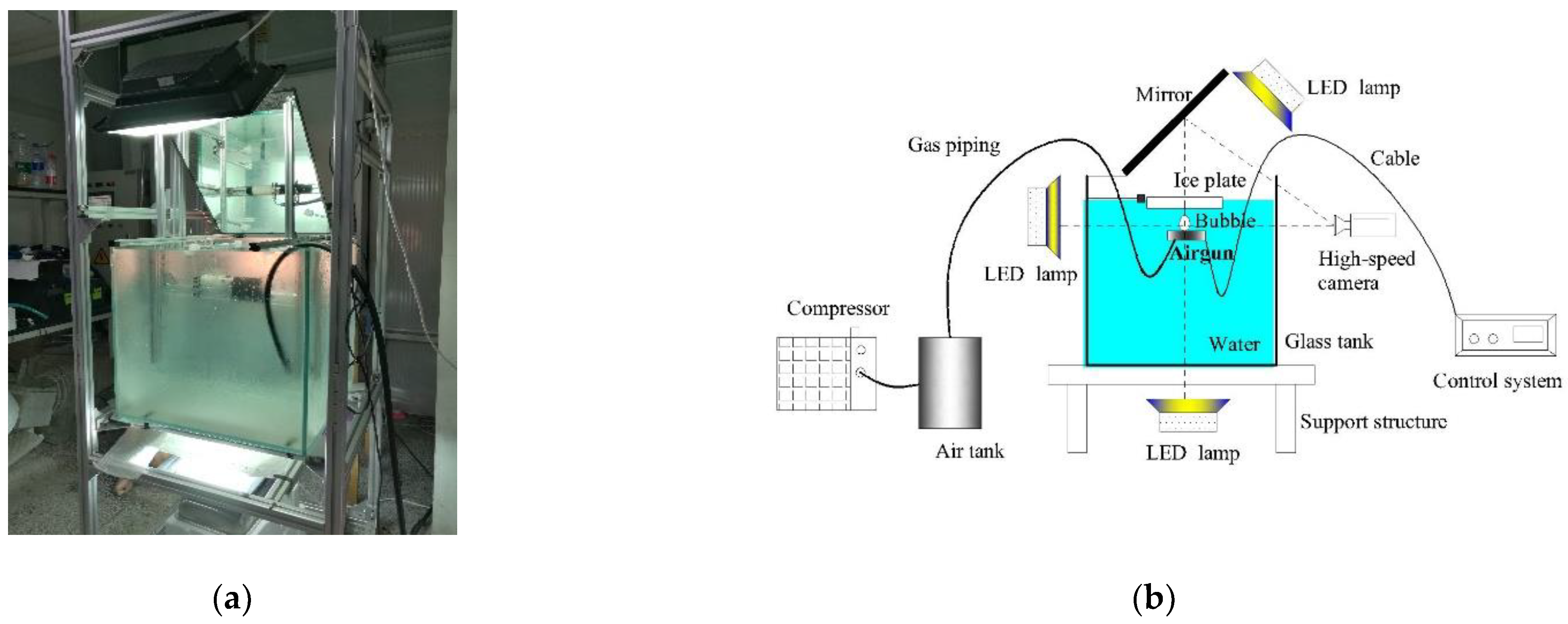
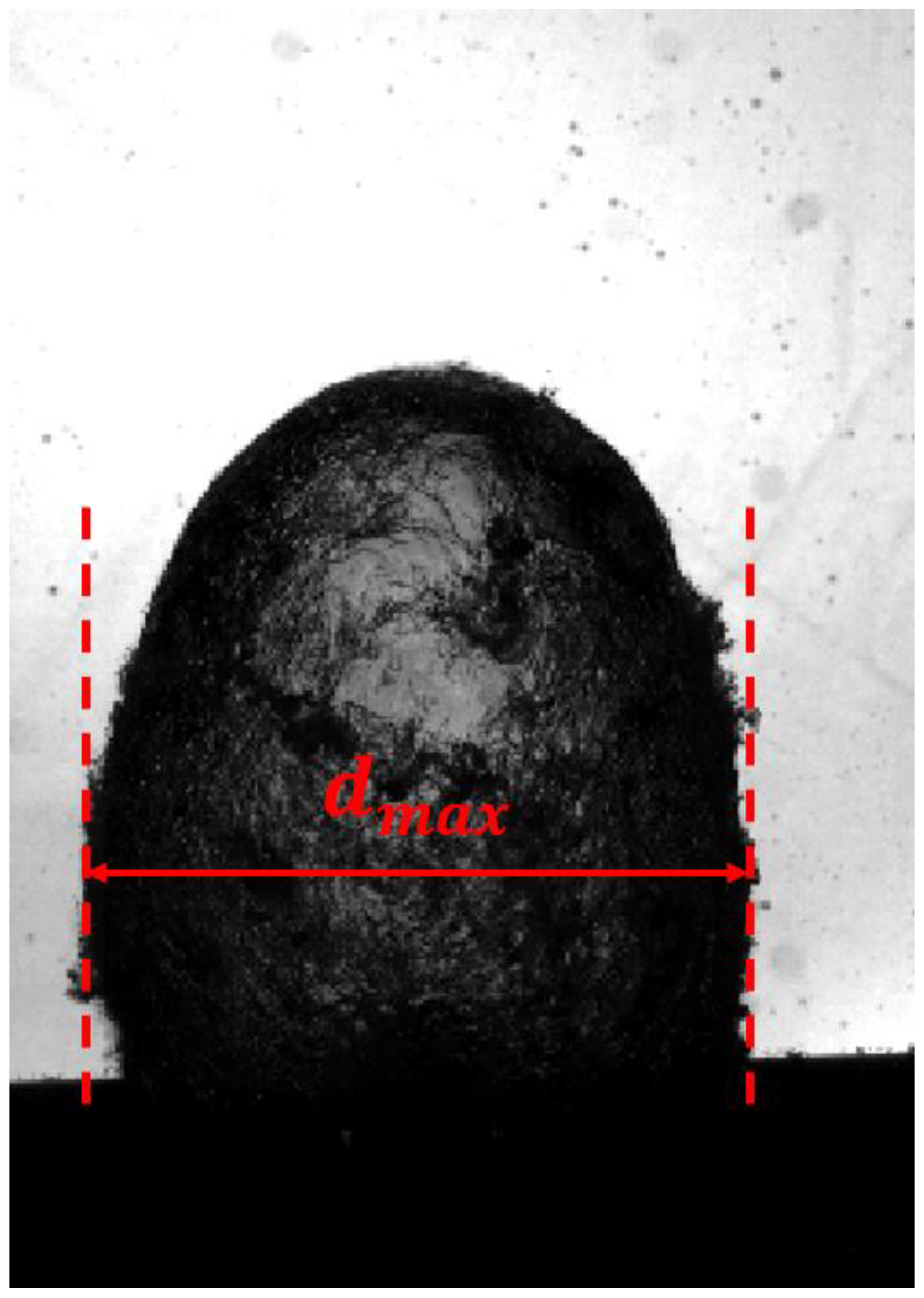
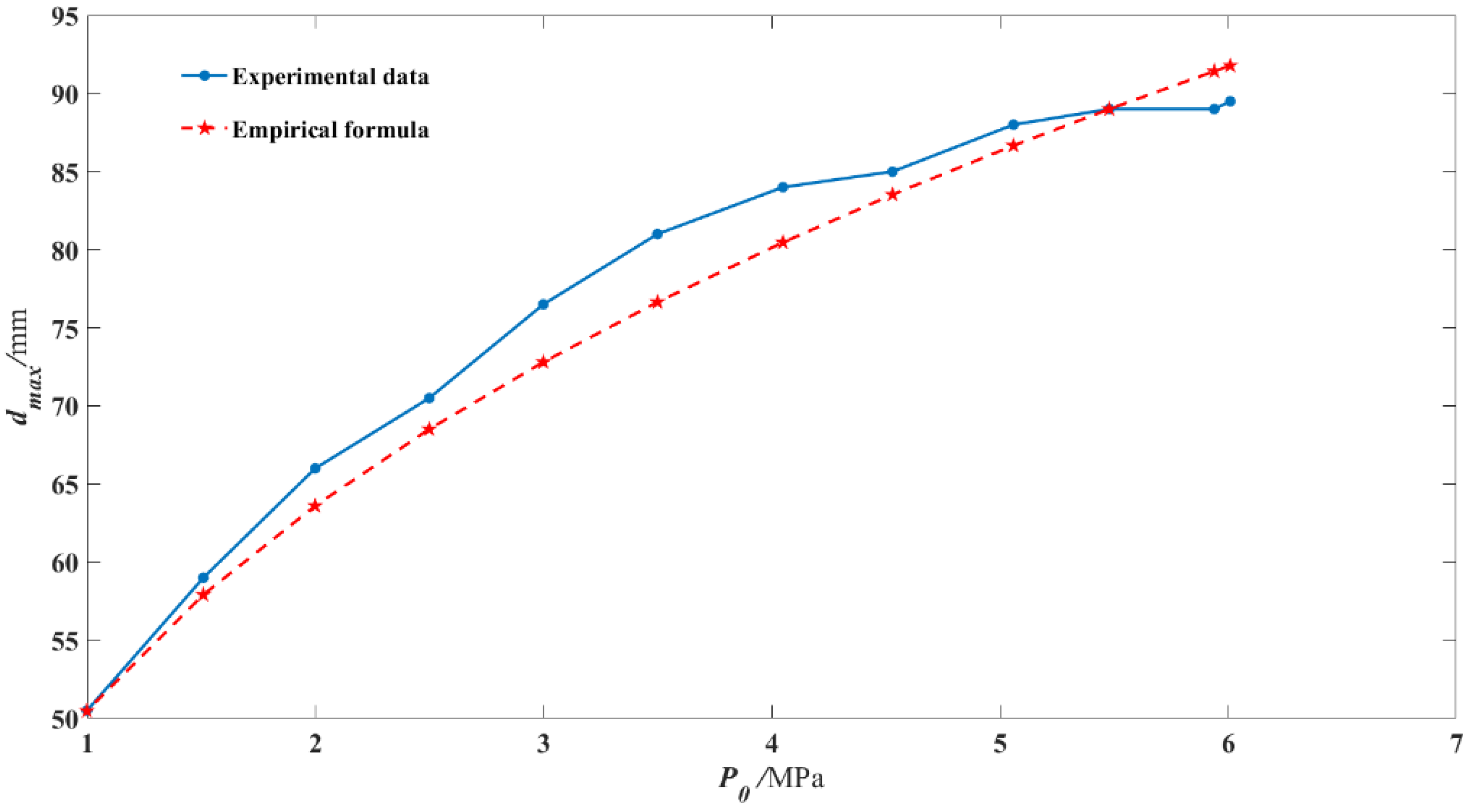
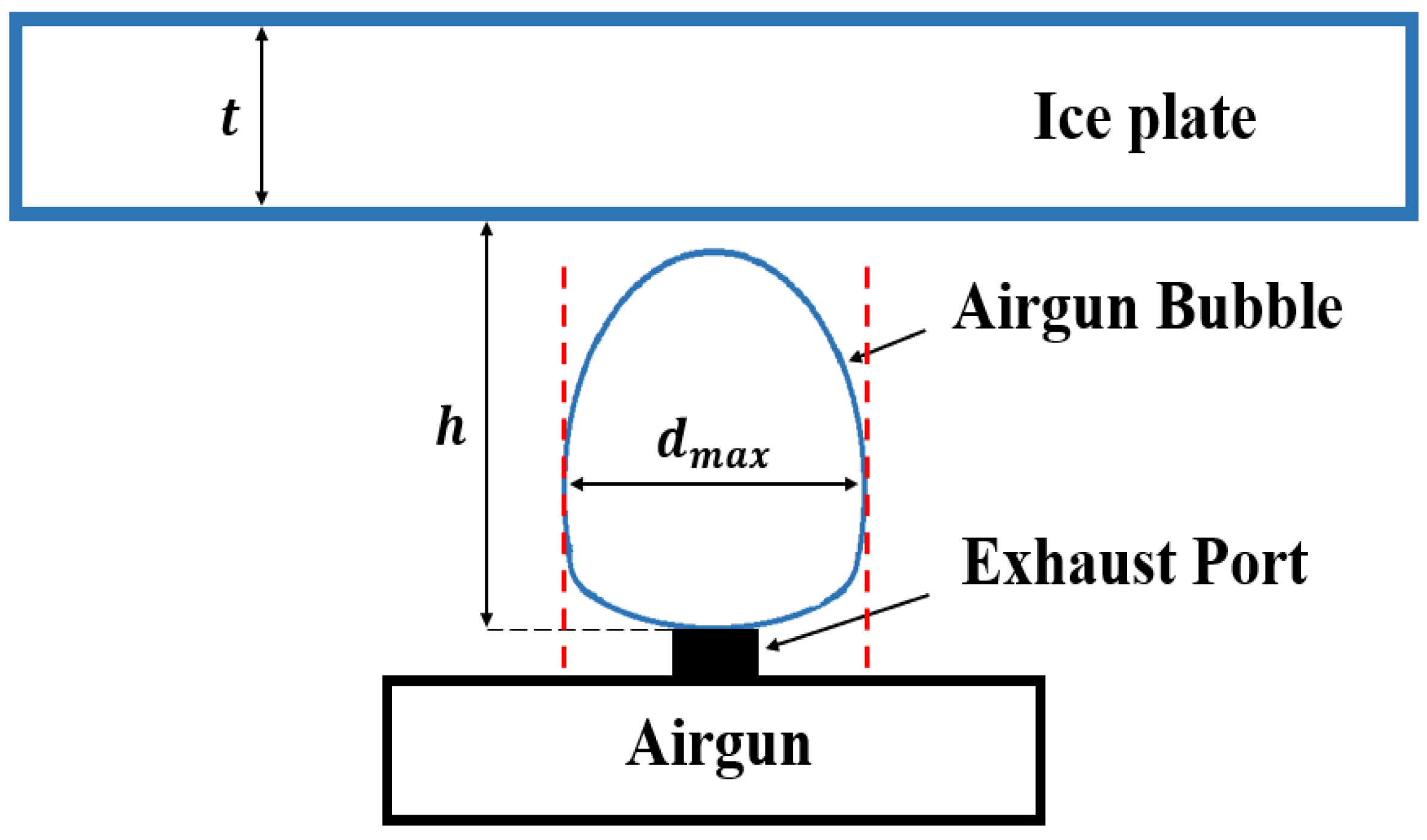

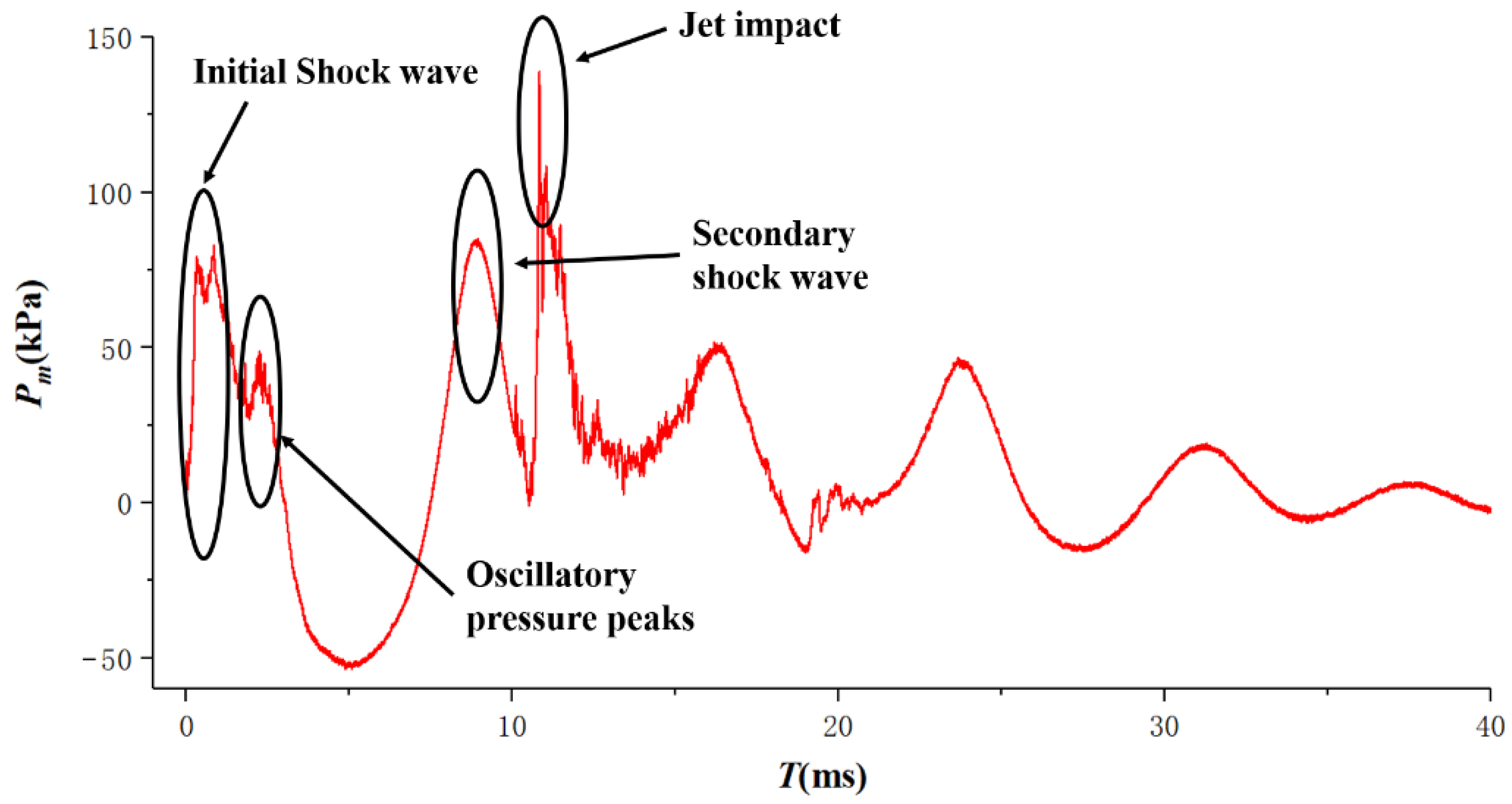

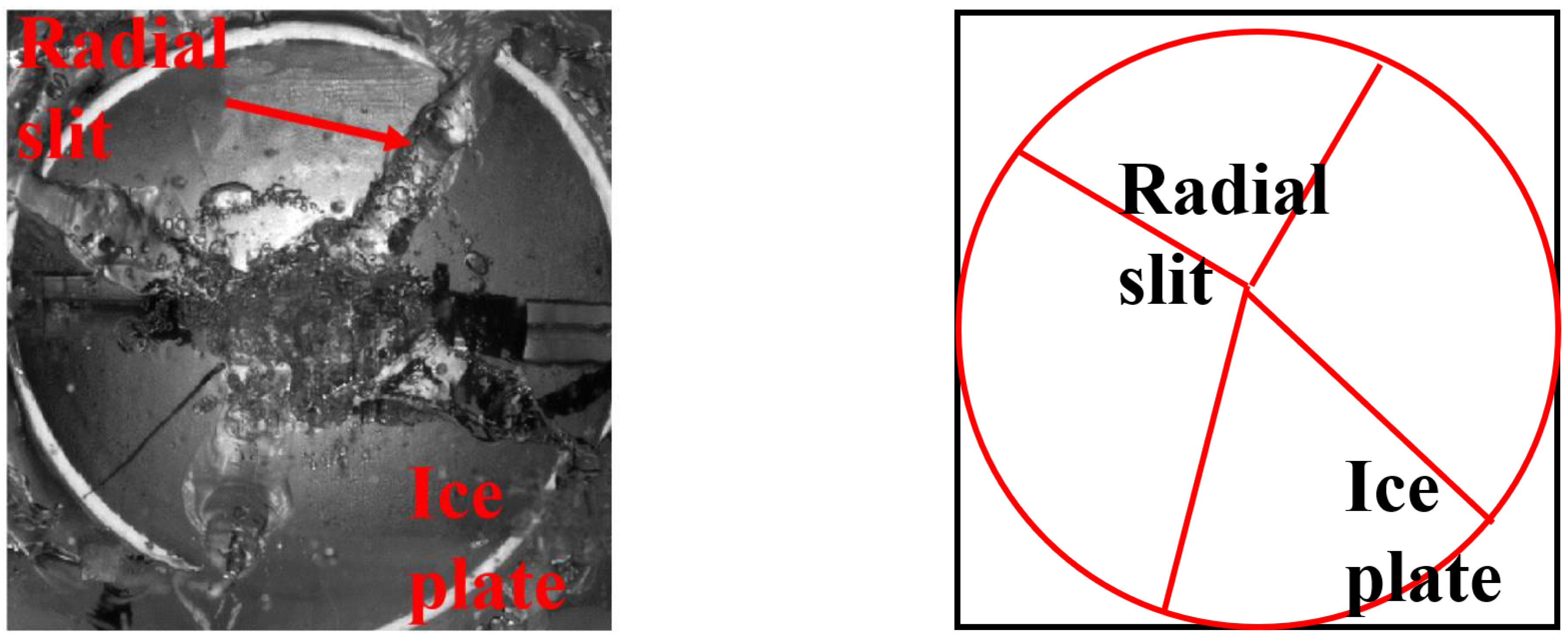
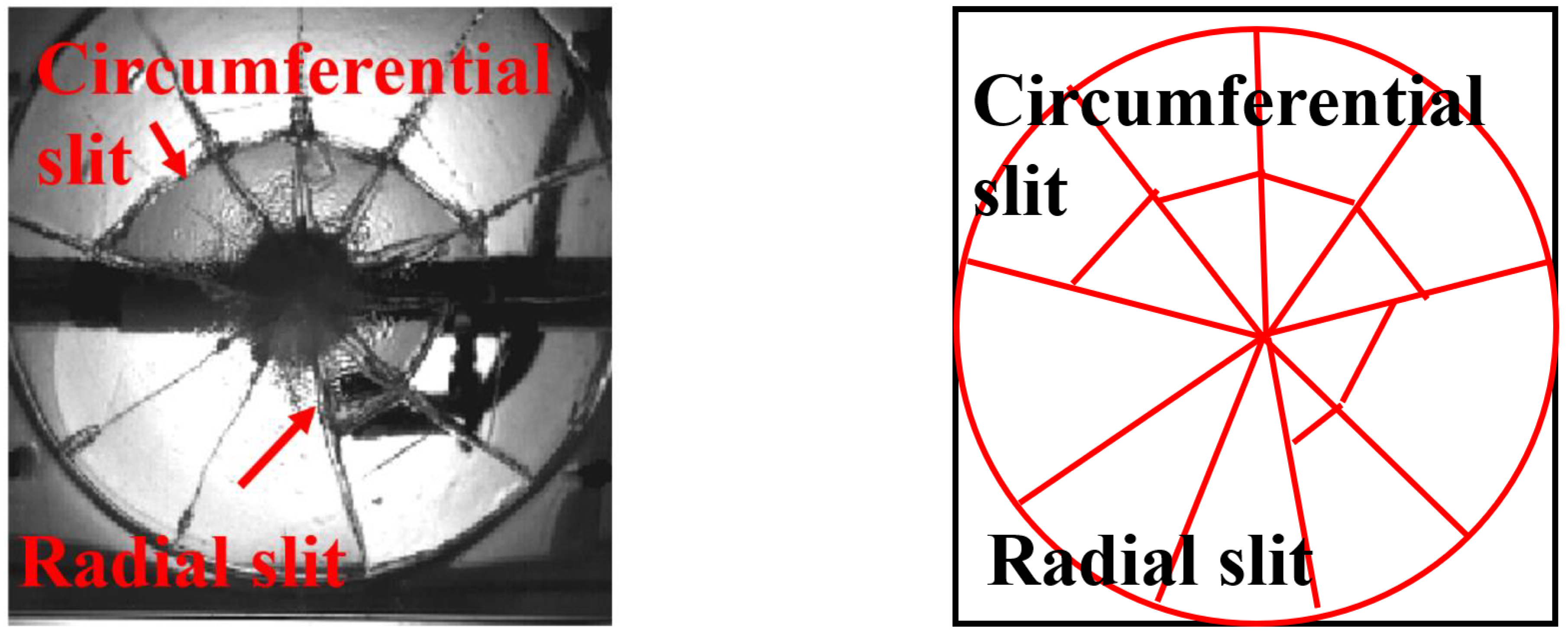
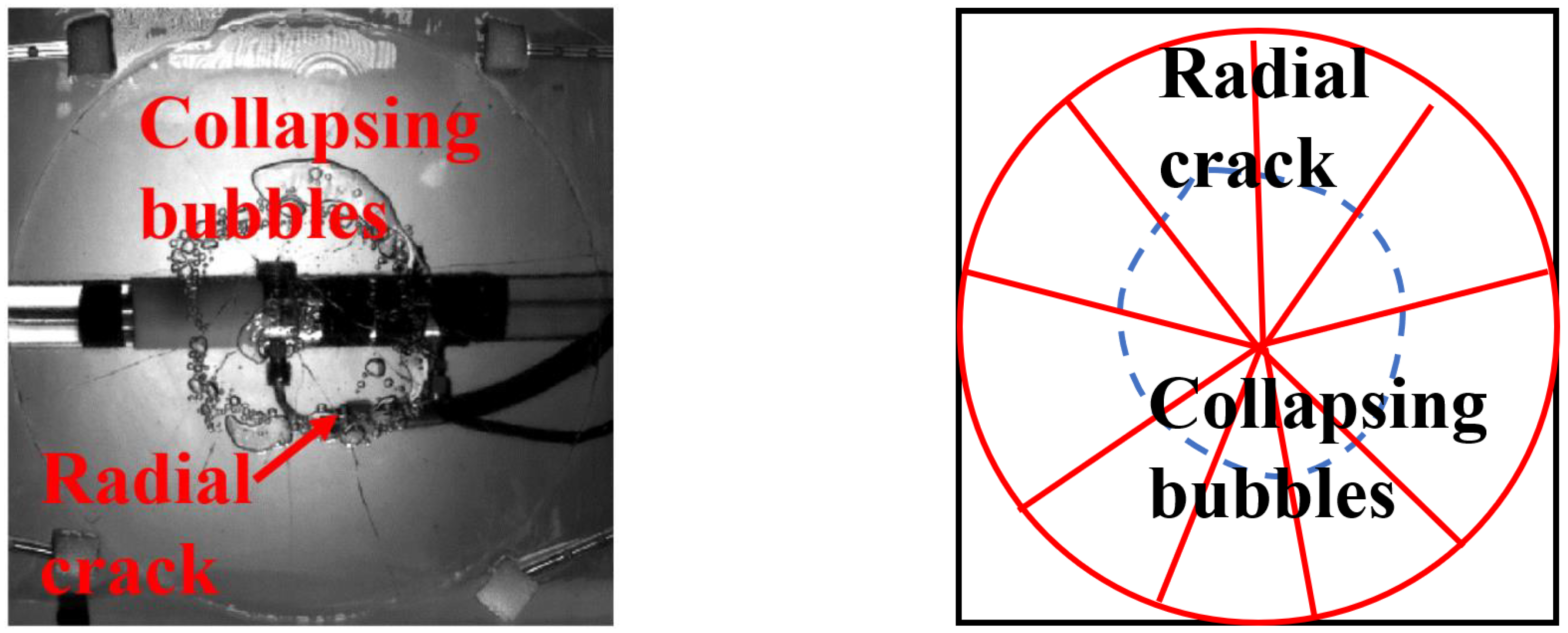

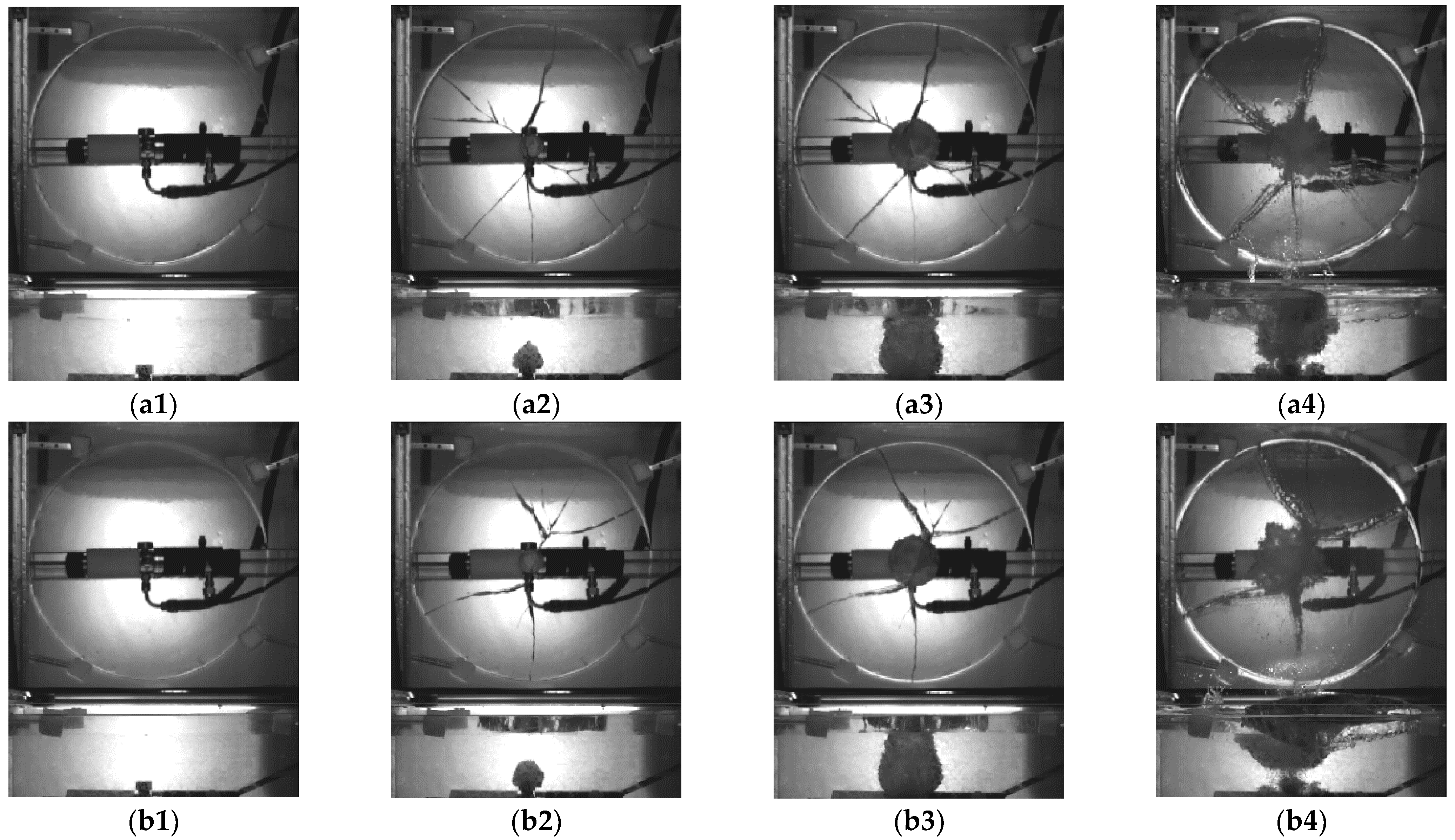
| T | 0.00–0.17 | 0.18–0.20 | 0.21–0.24 | 0.25–0.26 | 0.27–0.28 | 0.29–0.31 | ||||
|---|---|---|---|---|---|---|---|---|---|---|
| H | No. | |||||||||
| Small distance | 0.00–0.69 | 3 | 5 | 8 | 4 | 1 | ||||
| 0.70–0.76 | 1 | 7 | 4 | |||||||
| Medium distance | 0.77–0.84 | 2 | 1 | 7 | 4 | 3 | ||||
| 0.85–1.10 | 4 | 3 | 1 | 0 | 0 | |||||
| Large distance | 1.11–1.40 | 2 | 3 | 2 | 0 | 0 | ||||
| 1.41–2.30 | 3 | 2 | 1 | 0 | 0 | 0 | ||||
| Radial and circumferential slits | Radial slits (Shock wave) | Radial slits (Jet) | Radial cracks | No crack | ||||||
Publisher’s Note: MDPI stays neutral with regard to jurisdictional claims in published maps and institutional affiliations. |
© 2022 by the authors. Licensee MDPI, Basel, Switzerland. This article is an open access article distributed under the terms and conditions of the Creative Commons Attribution (CC BY) license (https://creativecommons.org/licenses/by/4.0/).
Share and Cite
Wu, Q.-G.; Wang, Z.-C.; Ni, B.-Y.; Yuan, G.-Y.; Semenov, Y.A.; Li, Z.-Y.; Xue, Y.-Z. Ice-Water-Gas Interaction during Icebreaking by an Airgun Bubble. J. Mar. Sci. Eng. 2022, 10, 1302. https://doi.org/10.3390/jmse10091302
Wu Q-G, Wang Z-C, Ni B-Y, Yuan G-Y, Semenov YA, Li Z-Y, Xue Y-Z. Ice-Water-Gas Interaction during Icebreaking by an Airgun Bubble. Journal of Marine Science and Engineering. 2022; 10(9):1302. https://doi.org/10.3390/jmse10091302
Chicago/Turabian StyleWu, Qi-Gang, Zuo-Cheng Wang, Bao-Yu Ni, Guang-Yu Yuan, Yuriy A. Semenov, Zhi-Yuan Li, and Yan-Zhuo Xue. 2022. "Ice-Water-Gas Interaction during Icebreaking by an Airgun Bubble" Journal of Marine Science and Engineering 10, no. 9: 1302. https://doi.org/10.3390/jmse10091302
APA StyleWu, Q.-G., Wang, Z.-C., Ni, B.-Y., Yuan, G.-Y., Semenov, Y. A., Li, Z.-Y., & Xue, Y.-Z. (2022). Ice-Water-Gas Interaction during Icebreaking by an Airgun Bubble. Journal of Marine Science and Engineering, 10(9), 1302. https://doi.org/10.3390/jmse10091302








